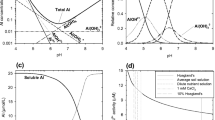Abstract
Aim
Highly alkaline soils (pH > 9.0) may adversely affect agricultural crop productivity. Problems encountered include poor structure and nutrient deficiency. Research based on solution cultures suggests that aluminium (Al) phytotoxicity may occur in soils with pH > 9.0, but little research has been undertaken on actual soils under controlled conditions. The nature of the Al species responsible and the pH regime of the soils when this occurs are unknown.
Methods
The charge and species of Al responsible for this toxicity was investigated using Zeta Potential measurement, Nuclear Magnetic Resonance (NMR) spectroscopy, Al precipitation characteristics and electrical conductivity as a function of pH. An anion exchange resin was used to evaluate Al availability to plants at alkaline pH. To verify Al phytotoxicity, a pot experiment was performed with plants grown at near neutral and high pH, with and without Al.
Results
The anionic aluminate species of aluminium was ubiquitous at highly alkaline pH, and was the dominant charged species at pH 9.2. Aluminium was phytotoxic at high pH, significantly reducing the stem and root development of field pea test plants over and above that caused by alkalinity alone. The effects of both alkalinity in general and aluminium in particular became noticeable at pH 9.0 and debilitating at pH > 9.2.
Conclusion
As this corresponds to the pH where aluminate becomes dominant, it is probably responsible for the phytotoxicity.







Similar content being viewed by others
References
Bertrand I, Janik LJ, Holloway RE, Armstrong RD, McLaughlin MJ (2002) The rapid assessment of concentrations and solid phase associations of macro- and micronutrients in alkaline soils by mid-infrared diffuse reflectance spectroscopy. Aust J Soil Res 40(8):1339–1356
Cooper DS (2004) Genetics and agronomy of tranient salinity in Triticum durum and T. aestivum., school of agriculture and wine. The University of Adelaide, Adelaide
Delhaize E, Ryan PR (1995) Aluminium toxicity and tolerance in plants. Plant Physiol 107:315–321
Guerinot ML (2007) It’s elementary: enhancing Fe3+ reduction improves rice yield. Proc Natl Acad Sci 104(18):7311–7312
Central Soil Salinity Research Institute (2007) Annual Report. Karnal, India
Isbell RF (1996) The Australian Soil Classification. CSIRO Publishing Collingwood, Victoria
Kinraide TB (1990) Assessing the rhizotoxicity of the aluminate ion, Al(OH)4−. Plant Physiol 93:1620–1625
Kochian LV (1995) Cellular mechanisms of aluminium toxicity and resistance in plants. Annu Rev Plant Physiol Plant Mol Biol 46:237–260
Kopittke PM, Menzies NW, Blamey FPC (2004) Rhizotoxicity of aluminate and polycationic aluminium at high pH. Plant Soil 266:177–186
Ma G, Rengasamy P, Rathgen AJ (2003) Phytotoxicity of aluminium to wheat plants in high-pH solutions. Aust J Exp Agric 43:497–501
Marion GM, Hendricks DM, Dutt GR, Fuller WH (1976) Aluminium and silica solubility in soils. Soil Sci 127:76–85
Northcote KH, Skene JKM (1972) Australian soils with saline and sodic properties. CSIRO Soil Publication, 27
Sarpola A (2007) The hydrolysis of aluminium, a mass spectrometric study. Faculty of technology, Department of process and environmental engineering, water resources and environmental engineering laboratory. University of Oulu, Oulu
Sipos P, Hefter G, May P (2006) Al NMR and Raman spectroscopic studies of alkaline aluminate solutions with extremely high caustic content—Does the octahedral species Al(OH) 3−6 exist in solution?, 1st workshop of the European Union: Analysis and removal of contaminants from wastewaters for the implementation of the Water Framework Directive—1st EMCO 2005. Talanta
Sposito G (1989) Soil particle surfaces. The chemistry of soils. Oxford university press, Oxford
Stass A, Wang Y, Eticha D, Horst WJ (2006) Aluminium rhizotoxicity in maize grown in solutions with Al3+ or Al(OH) −4 as predominant solution Al species. J Exp Bot 57:4033–4042
Tyler G (1994) Plant uptake of aluminium from calcareous soils. Experientia 50:701–703
vanRaij B, Cantarella H, Quaggio JA, Prochnow LI (2009) Ion exchange resin for assessing phosphorus availability in soils. Better Crops 93(1):23–25
Wilhelm N, Hollaway K (1998) Persistence of sulfonylurea herbicides on alkaline soils. 9th Australian Agronomy Conference. Wagga Wagga
Acknowledgments
We would like to thank; Mrs Alla Marchuk for the technical support of the project. Future Farms Industry CRC and Grains Research and Development Corporation for their financial support.
Author information
Authors and Affiliations
Corresponding author
Additional information
Responsible Editor: Fangjie Zhao.
Rights and permissions
About this article
Cite this article
Brautigan, D.J., Rengasamy, P. & Chittleborough, D.J. Aluminium speciation and phytotoxicity in alkaline soils. Plant Soil 360, 187–196 (2012). https://doi.org/10.1007/s11104-012-1232-5
Received:
Accepted:
Published:
Issue Date:
DOI: https://doi.org/10.1007/s11104-012-1232-5




